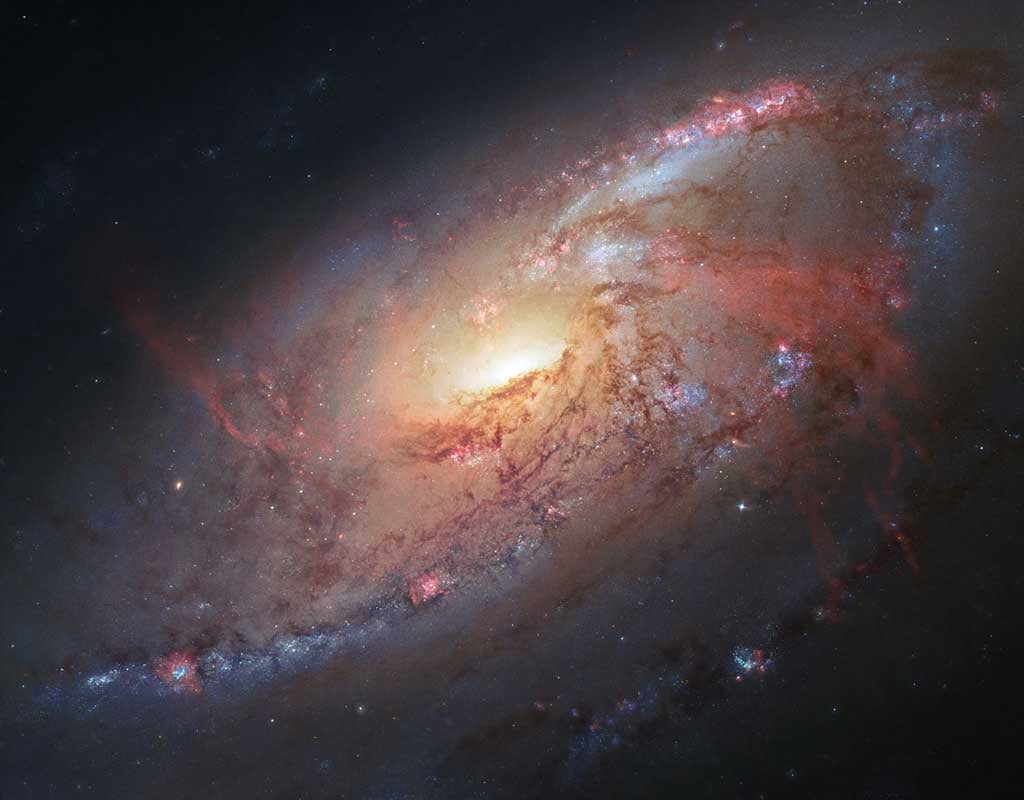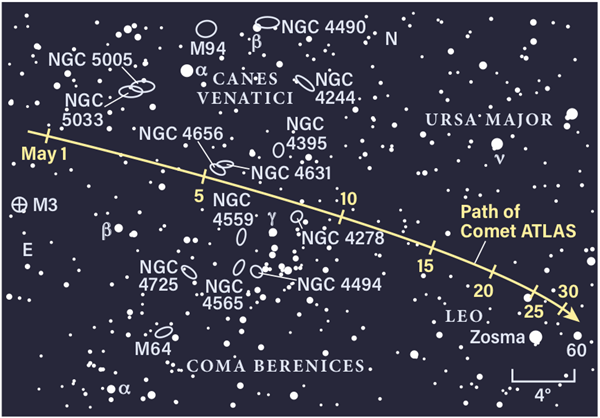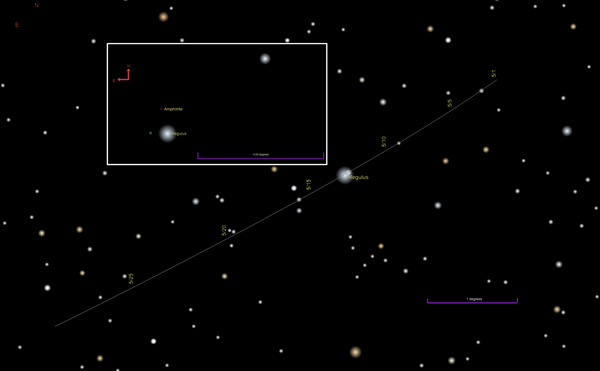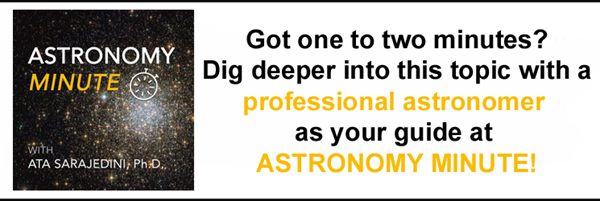Friday, May 7
Canes Venatici the Hunting Dogs is a northern constellation drawn from just two bright stars: magnitude 3 Alpha (α) and magnitude 4 Beta (β) Canum Venaticorum. They sit below the curve of the Big Dipper’s handle, parallel to Alkaid and Mizar but about 15° southwest of that pair.
The constellation is home to several relatively bright galaxies, including magnitude 8.4 M106. Measuring 20.0′ by 8.4′, many consider it one of the best galaxies in Messier’s list, but it’s also one of the least observed. You’ll find this spiral in the constellation’s northwest corner, about 6.5° northwest of Beta Canum Venaticorum and 7.5° southeast of magnitude 2.4 Phecda (Gamma [γ] Ursae Majoris). You’ll want to pull out your best scope for M106, which is tilted to our line of sight much like the more famous Andromeda Galaxy (M31) and resembles that object as well. With larger apertures, you’ll be able to make out the galaxy’s dust lanes and spiral structure.
Canes Venatici is home to several other Messier objects: galaxies M94, M51, and M63, as well as the globular cluster M3.
Sunrise: 5:53 A.M.
Sunset: 8:01 P.M.
Moonrise: 4:19 A.M.
Moonset: 4:12 P.M.
Moon Phase: Waning crescent (15%)
*Times for sunrise, sunset, moonrise, and moonset are given in local time from 40° N 90° W. The Moon’s illumination is given at 12 P.M. local time from the same location.
euSaturday, May 8
May is your last chance to see Comet C/2020 R4 (ATLAS) before it streaks too far from the Sun and loses its glow. It won’t return for another 1,000 years, so get your comet watching on before midmonth, when the Moon’s bright light drowns it out.
ATLAS is currently gliding through Coma Berenices, just south of Canes Venatici (where we turned our gaze last night). This evening, you’ll find the magnitude 10 comet about 2.5° north of Gamma Comae Berenices; nearby are several galaxies around the same magnitude: NGC 4559, NGC 4565, NGC 4494, NGC 4631, and NGC 4395.
The comet will continue toward Leo night by night, heading nearly straight for Zosma in the great cat’s haunches.
Sunrise: 5:52 A.M.
Sunset: 8:02 P.M.
Moonrise: 4:42 A.M.
Moonset: 5:12 P.M.
Moon Phase: Waning crescent (9%)
Sunday, May 9
Let’s return to Coma Berenices tonight to enjoy NGC 4565, one of the sky’s best edge-on galaxies. Even a small telescope (4 inches) will show this magnitude 9.5 galaxy, also known as the Needle Galaxy for its exceedingly thin appearance. If we could step outside the Milky Way and view it edge on, it would likely look quite similar. Although it sits some 30 million light-years away, thanks to projection effects NGC 4565 appears to sit near the edge of the much closer Coma Star Cluster (Melotte 111).
Melotte 111 itself is an excellent binocular object that can be found just south of Gamma Comae Berenices, which Comet ATLAS passed last night. The cluster’s 40-odd members form a loose v shape visible to the naked eye in a dark sky. It spans about 275′ and sits a little less than 300 light-years away.
Sunrise: 5:51 A.M.
Sunset: 8:03 P.M.
Moonrise: 5:04 A.M.
Moonset: 6:10 P.M.
Moon Phase: Waning crescent (4%)
Monday, May 10
Mercury passes 8° north of Aldebaran at 11 P.M. EDT. Although they will have set by then, you can catch the pair sinking in the west just after sunset. Closest to the horizon is bright Venus, blazing at magnitude –3.9 and roughly 10″ in diameter. About 9° northeast of Venus is Mercury, a much dimmer –0.3 and spanning 7″. The red giant star Aldebaran, which marks the eye of Taurus the Bull, is south of the tiny planet.
Northwest of Venus (and roughly the same height above the horizon) is the Pleiades. See if you can spot any of the cluster’s bright stars popping out as dusk falls and the cluster quickly sets. You’ll definitely need a clear view of the horizon.
Much higher in the sky, now sitting near the knees of Gemini the Twins, is ruddy Mars, shining at magnitude 1.6. It will take longer for the Red Planet to show up against the darkening sky, but it will also remain above the horizon longer, setting around local midnight.
Sunrise: 5:20 A.M.
Sunset: 8:04 P.M.
Moonrise: 5:28 A.M.
Moonset: 7:10 P.M.
Moon Phase: Waning crescent (1%)
Tuesday, May 11
Dedicated predawn observers can catch a mutual event between two of Jupiter’s Galilean moons this morning. First, find the bright magnitude –2.3 planet in the southeast before dawn. Jupiter currently sits in Aquarius, while Saturn (magnitude 0.5) hangs nearby in Capricornus, to Jupiter’s upper right. Neptune, not visible without binoculars or a telescope at magnitude 7.8, lies about 23° east-northeast of Jupiter, near the eastern edge of Aquarius and below the Circlet of Pisces.
Next, zoom in with a telescope on the solar system’s largest planet to catch the action: Beginning at 5:06 A.M. EDT, Europa’s shadow will eclipse the larger Ganymede. The event will only last a few minutes, ending by 5:15 A.M. EDT. Even if you aren’t able to catch the eclipse itself, you can still enjoy the scene: Io (closest) and Callisto (farthest) are on Jupiter’s west, while Ganymede (closest) and Europa (farthest) sit to the planet’s east.
New Moon occurs at today 3 P.M. EDT. Nearly three hours later, the Moon reaches apogee — the farthest point from our planet in its orbit around Earth — at 5:53 P.M. EDT. At that time, it will be 252,595 miles (406,512 kilometers) away.
Sunrise: 5:49 A.M.
Sunset: 8:05 P.M.
Moonrise: 5:53 A.M.
Moonset: 8:09 P.M.
Moon Phase: New
Wednesday, May 12
There’s action in the west again around sunset: The Moon passes 0.7° south of Venus at 6 P.M. EDT, but you’ll need to wait for sunset to easily and safely view the scene. Twenty minutes after the Sun disappears, see if you can find the delicate crescent Moon, now sitting just over 1° southeast of the planet. A Moon this thin (roughly 1.4 percent lit) can be a major challenge, so take your time and use binoculars or a telescope — once the Sun is safely out of the picture.
The planet Mercury sits about 9° above the pair, which will set just after 9 P.M. local time. Mercury remains visible about 50 minutes longer.
Sunrise: 5:48 A.M.
Sunset: 8:06 P.M.
Moonrise: 6:21 A.M.
Moonset: 9:10 P.M.
Moon Phase: Waxing crescent (1%)
Thursday, May 13
The Moon passes 2° south of Mercury at 2 P.M. EDT. Look west after sunset again this evening to find our satellite, now nearly 5 percent lit, a little over 3° southeast of the planet, still hanging in Taurus.
Then, once it’s dark, turn your gaze to Leo the Lion, still relatively high in the southwest. Leo’s brightest star, Regulus, is the one you’ll want to zoom in on with binoculars or, better yet, a small scope. Tonight, asteroid 29 Amphitrite is skimming just north of the magnitude 1.4 star. For reference, look northwest of Regulus to spot a magnitude 8 field star; Amphitrite is three times closer to Regulus than this star is. After passing, the asteroid will continue to move southeast through the constellation, as if making a beeline for Rho (ρ) Leonis.
Although this is a near miss, not all such events are — asteroidoccultations.com hosts a list of upcoming occultations and their visibility.
Sunrise: 5:47 A.M.
Sunset: 8:07 P.M.
Moonrise: 6:54 A.M.
Moonset: 10:09 P.M.
Moon Phase: Waxing crescent (3%)
Friday, May 14
With such a slim Moon in the sky, tonight is a great night for hunting down the heart of a famous cluster of galaxies. The Virgo Cluster is located (predictably) in the constellation Virgo, which you’ll find in the south after sunset. Look for the constellation’s brightest star, magnitude 1 Spica, and draw a line to the northwest, connecting Spica and magnitude 3.4 Auva (Delta [δ] Virginis). Follow that like further northwest and you’ll reach the center of the Virgo Cluster, which is dominated by several large elliptical galaxies: M49, M60, M84, M86, and M87. (If that last galaxy sounds familiar, it’s likely because M87’s supermassive black hole was the first one caught on “film” when the Event Horizon Telescope Collaboration released an image of the shadow around the black hole in 2019.)
You can spot any of these bright ellipticals, which sit roughly 50 million light-years away, in a 3-inch (or larger) scope. They cover a relatively large field, so you’ll want to choose an eyepiece with a wide field of view. Alternatively, you can pump up the magnification and switch from target to target.
Sunrise: 5:46 A.M.
Sunset: 8:08 P.M.
Moonrise: 7:33 A.M.
Moonset: 11:06 P.M.
Moon Phase: Waxing crescent (7%)













